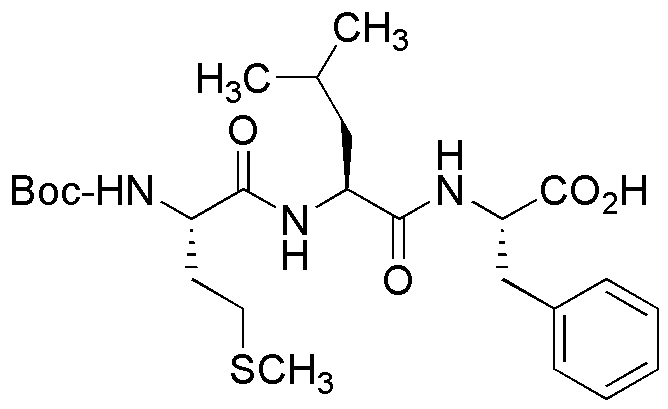Boc-Met-Leu-Phe-OH is widely utilized in research focused on:
- Peptide Synthesis: This compound serves as a key building block in the synthesis of peptides, which are essential for developing new drugs and therapies in pharmaceuticals.
- Drug Development: It plays a significant role in the design of peptide-based drugs, particularly in targeting specific receptors in the body, enhancing efficacy and reducing side effects.
- Biotechnology: Researchers use it in the production of biologics, including therapeutic proteins and antibodies, which are crucial for treating various diseases.
- Research in Cancer Therapy: The compound is investigated for its potential in developing targeted cancer therapies, as it can be modified to bind selectively to cancer cells.
- Diagnostic Applications: It is also used in the creation of diagnostic tools that utilize peptide markers for early detection of diseases, improving patient outcomes.
General Information
Properties
Safety and Regulations
Applications
Boc-Met-Leu-Phe-OH is widely utilized in research focused on:
- Peptide Synthesis: This compound serves as a key building block in the synthesis of peptides, which are essential for developing new drugs and therapies in pharmaceuticals.
- Drug Development: It plays a significant role in the design of peptide-based drugs, particularly in targeting specific receptors in the body, enhancing efficacy and reducing side effects.
- Biotechnology: Researchers use it in the production of biologics, including therapeutic proteins and antibodies, which are crucial for treating various diseases.
- Research in Cancer Therapy: The compound is investigated for its potential in developing targeted cancer therapies, as it can be modified to bind selectively to cancer cells.
- Diagnostic Applications: It is also used in the creation of diagnostic tools that utilize peptide markers for early detection of diseases, improving patient outcomes.
Documents
Safety Data Sheets (SDS)
The SDS provides comprehensive safety information on handling, storage, and disposal of the product.
Product Specification (PS)
The PS provides a comprehensive breakdown of the product’s properties, including chemical composition, physical state, purity, and storage requirements. It also details acceptable quality ranges and the product's intended applications.
Certificates of Analysis (COA)
Search for Certificates of Analysis (COA) by entering the products Lot Number. Lot and Batch Numbers can be found on a product’s label following the words ‘Lot’ or ‘Batch’.
*Catalog Number
*Lot Number
Certificates Of Origin (COO)
This COO confirms the country where the product was manufactured, and also details the materials and components used in it and whether it is derived from natural, synthetic, or other specific sources. This certificate may be required for customs, trade, and regulatory compliance.
*Catalog Number
*Lot Number
Safety Data Sheets (SDS)
The SDS provides comprehensive safety information on handling, storage, and disposal of the product.
DownloadProduct Specification (PS)
The PS provides a comprehensive breakdown of the product’s properties, including chemical composition, physical state, purity, and storage requirements. It also details acceptable quality ranges and the product's intended applications.
DownloadCertificates of Analysis (COA)
Search for Certificates of Analysis (COA) by entering the products Lot Number. Lot and Batch Numbers can be found on a product’s label following the words ‘Lot’ or ‘Batch’.
*Catalog Number
*Lot Number
Certificates Of Origin (COO)
This COO confirms the country where the product was manufactured, and also details the materials and components used in it and whether it is derived from natural, synthetic, or other specific sources. This certificate may be required for customs, trade, and regulatory compliance.


